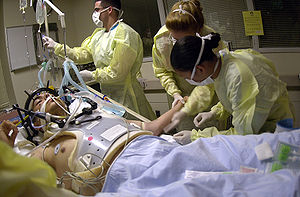Injure
| Major trauma | |
|---|---|
 |
|
| Health care providers attending to a person on a stretcher with a gunshot wound to the head, the patient is intubated, and a mechanical ventilator is visible in the background | |
| Classification and external resources | |
| Specialty | Emergency medicine |
| ICD-10 | T79 |
| ICD-9-CM | 900-957 |
| DiseasesDB | 28858 |
| MedlinePlus | 000024 |
| eMedicine | trauma |
| MeSH | D014947 |
Major trauma is any injury that has the potential to cause prolonged disability or death. There are many causes of major trauma, blunt and penetrating, including falls, motor vehicle collisions, stabbing wounds, and gunshot wounds. Depending on the severity of injury, quickness of management and transportation to an appropriate medical facility (called a trauma center) may be necessary to prevent loss of life or limb. The initial assessment is critical, and involves a physical evaluation and also may include the use of imaging tools to determine the types of injuries accurately and to formulate a course of treatment.
In 2002, unintentional and intentional injuries were the fifth and seventh leading causes of deaths worldwide, accounting for 6.23% and 2.84% of all deaths. For research purposes the definition often is based on an injury severity score (ISS) of greater than 15.
Injuries generally are classified by either severity, the location of damage, or a combination of both. Trauma also may be classified by demographic group, such as age or gender. It also may be classified by the type of force applied to the body, such as blunt trauma or penetrating trauma. For research purposes injury may be classified using the Barell matrix, which is based on ICD-9-CM. The purpose of the matrix is for international standardization of the classification of trauma. Major trauma sometimes is classified by body area; injuries affecting 40% are polytrauma, 30% head injuries, 20% chest trauma, 10%, abdominal trauma, and 2%, extremity trauma.
...
Wikipedia
